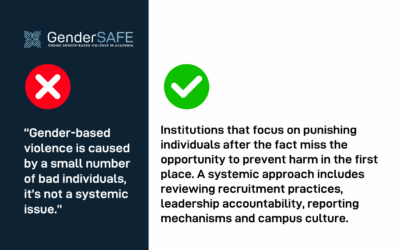Protecting victims/survivors
Among the 43 researchers interviewed within UniSAFE’s qualitative research, the majority stated that perpetrators in their institution were not sanctioned for their actions. In some cases, these individuals not only escaped accountability, but were even promoted, continuing to be regarded as respected members of the research performing organisation Blazyte et al (2023). Given this, it’s unsurprising that so few students and researchers report cases of gender-based violence, considering their voices will go unheard and their situations unchanged Lipinsky et al. (2022); Humbert et al. (2022). One respondent captured this feeling:
“You hear people say […] you should actually file a complaint about that, […] but it wouldn’t make a difference’. And it would only be hard on me and my career. So, people self-silence […] to protect themselves”. (Associate Professor at the time of the interview, woman, age 40-49) Blazyte et all (2023).
How often do we witness institutions shielding “respected members of the community” against allegations of gender-based violence? This institutional inaction not only perpetuates harm but also deters others from coming forward.
Reporting gender-based violence requires immense courage. However, the reality for many survivors is that doing so becomes a deeply painful process and in some cases even causing them to relive a traumatic experience.
Institutions have a crucial role to play not only to protect their staff and students, but also to ensure all procedures addressing cases of gender-based violence place the needs and priorities of victims/survivors of violence at the forefront of any response, adopting a victim-centred approach.
What is a victim-centred approach?
The zero-tolerance code of conduct published by the European Commission invites research and academic institutions to adopt a “whole-of-institution, trauma-informed and victim- and survivor-centred approach”.
Adopting a victim-centred approach entails “prioritising listening to the victim(s), avoiding re-traumatisation and systematically focusing on their safety, rights, well-being, expressed needs and choices, thereby giving back as much control to victim(s) as feasible and ensuring the empathetic and sensitive delivery of services and accompaniment in a non-judgmental manner.
How to adopt a victim-centred approach in practice?
Along the lines of the 7P model, a victim-centred and trauma-informed approach should be adopted at all levels of addressing gender-based violence in an institution. The UniSAFE guidelines to develop an institutional protocol provide concrete recommendations in this area. This blog post highlights recommendations particularly related to protection, prosecution, and provision of services, summarised as follows:
Protection
- Protective measures should be designed to avoid (potential) victims and survivors suffering (further) harm, in the form of retaliation, social exclusion or otherwise. To this end, a victim-centred approach should be taken to all protective measures. While such protective measures are decided on a case-by-case basis, it is important for institutions to have a repository of possible measures when dealing with a specific case.
Prosecution
When handling cases of gender-based violence within the institution, investigative actions, disciplinary procedures and sanctions for perpetrators must be mainstreamed with a victim-centred, trauma-informed and gender-responsive approach. The UniSAFE guidelines for developing a protocol provide specific recommendations as for instance:
- Highlight the importance of making the person who filed the complaint feel heard and taken seriously
- Re-traumatisation should be avoided throughout the process – for example, by recording the victim’s testimony and report instead of requiring the person to repeat their story several times in different instances.
- Investigators should be trained on understanding violence against women and gender-based violence (e.g. the role of social norms in perpetuating victim-blaming) and equipped with knowledge in conducting investigations in a gender-responsive and trauma-informed way (e.g. understanding trauma and its impact on the brain, on memory and the reporting of abuse).
- The anonymity of victims/survivors and witnesses should be maintained to the greatest extent possible when reporting on investigations.
- Ensure that the burden of following the correct steps and procedures does not fall solely on the victims/survivors and bystanders. It is the responsibility of the institution to provide clear guidance, support, and resources to facilitate the reporting and investigation process – for example, by appointing a qualified case manager.
Provision of services
- Staff members of the service should be trained and qualified professionals, able to offer support and guidance and respond to the needs of survivors with sensitivity and understanding. It is paramount that their approach is trauma-informed and victim-centred. Any personal information about the service users is to be treated confidentially.
- In a training session, it is important to ensure that participants feel comfortable, respected and supported throughout the training, preventing re-traumatising and triggering of the participants.
Read through the UniSAFE guide: Creating a safe space for discussion and dialogue in a training session on gender-based violence (online & offline) for further information!




